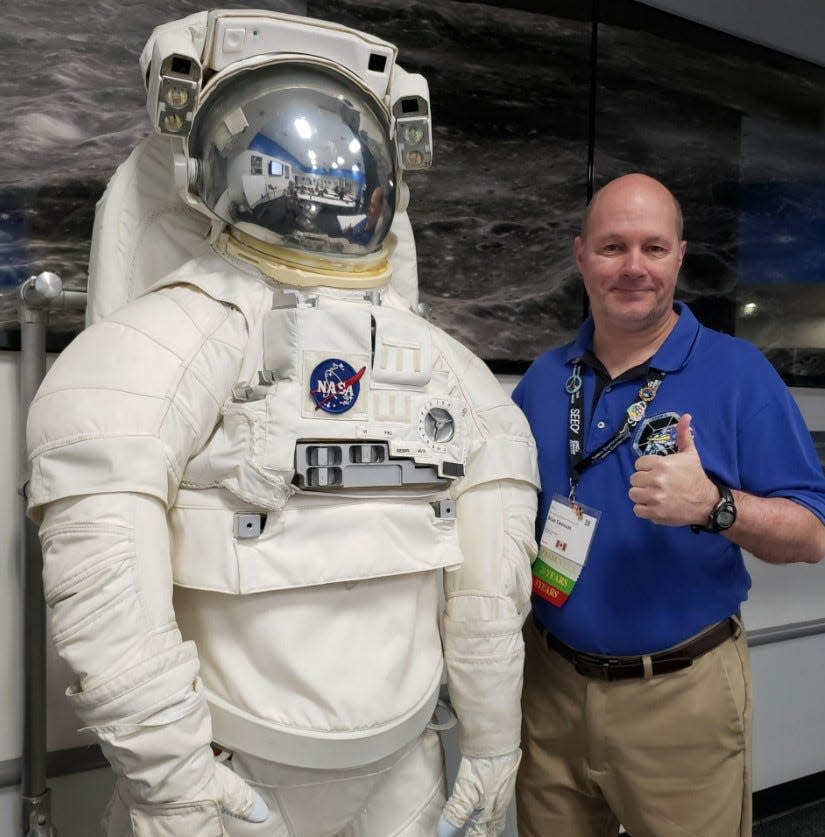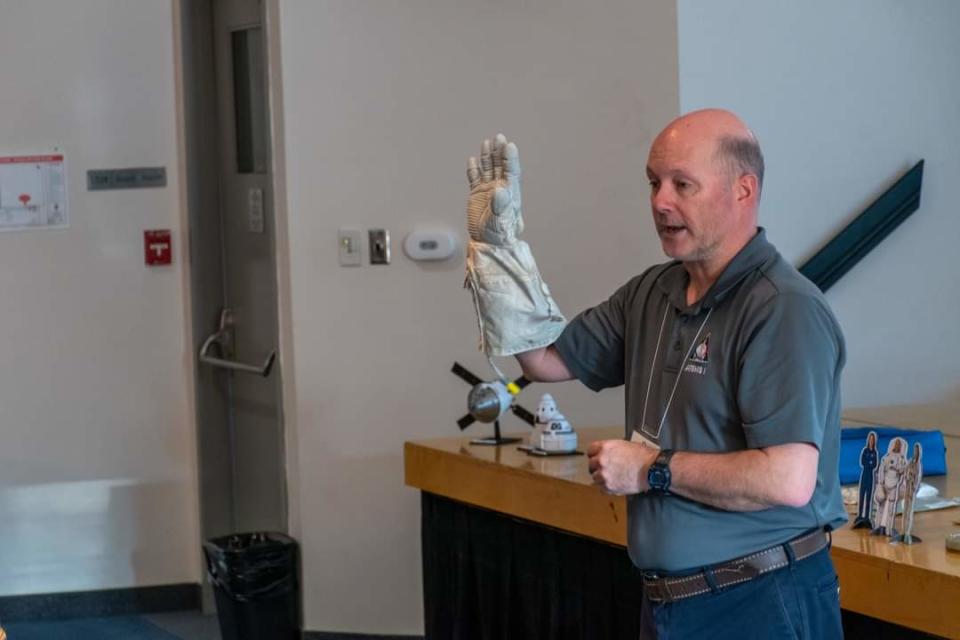This aerospace educator worked with NASA and astronaut John Glenn. Now, he's helping Wisconsin students reach careers in flight.

SHEBOYGAN - When kids are asked what they want to be when they grow up, “astronaut” is often among responses.
Aerospace educator Brian Ewenson experienced something similar. After visiting the Kennedy Space Center at the age of 4, he knew he wanted to work with airplanes and spaceships.
With a background in astrophysics, his career reel has many accomplishments.
He’s worked for the Canadian Space Agency and Lockheed Martin’s Space Day and Challenger Learning Centers, conceptualized and designed an international airport’s first air and space museum called Spaceport Calgary, developed eight flight experiments on the Space Shuttle and International Space Station, and served as a flight attendant aboard several aircrafts.
Another definite highlight was working with former senator and astronaut John Glenn.
“Getting to work with a true American hero absolutely was a great thing in my career,” Ewenson told the Sheboygan Press.
Today, he travels across the U.S. and Canada sharing his NASA and aviation experiences with kids, adults and especially students to show what opportunities exist in space and aviation fields.
For him and his twin brother, who is an Air Canada captain, Ewenson tracks the beginning of their careers back to the Kennedy Space Center trip.
“Neither of my parents were scientists or engineers,” he said. “By exposing us to that environment at four years old … our careers literally took off.”
Ewenson strives to do the same for students, some in the Sheboygan area who are learning about air and space travel for the first time.
“We have a lot of students in particular in the rural areas that have never ever been on board a commercial aircraft,” he said. “It's giving them the opportunities to learn what is out there — how airports and airplanes operate.”
Opportunities in the state and county exist at several state-based companies, like Sierra Nevada Corporation in Madison and Amorim Cork Composites in Trevor, that develop materials used in space programs, and the Sheboygan County Memorial Airport.
“You can do stuff right in your own home state without having to leave,” Ewenson said.

In his presentations, Ewenson also answers common questions about life in space (like the million-dollar question: How do astronauts use the bathroom?) and shows real astronaut food (not the commercially sold astronaut ice cream).
Groups can also see and touch space artifacts from Ewenson’s personal collection of space memorabilia (the second largest in the nation), including space shuttle heat tiles, astronaut sleeping bags, space gloves and a space suit.
"Especially returning to school and post-COVID, I asked the students, ‘Did you buy a new pair of pants coming back to school after COVID?' And they invariably say, ‘Yes,’” Ewenson said. Then he asks, “’Have your parents ever bought you a $3 million pair of pants?’ And their jaws drop. Even the adults when they see those kinds of things.”

While he’s often been at the forefront of innovation and has worked with several of his heroes, Ewenson said this time of year is a difficult time.
“This month (January), in particular, is very, very tough for those of us who've worked in the space program,” Ewenson said. “All three of NASA's accidents where astronauts lost their lives happened in January and February.”
In 1967, three astronauts died when a fire swept the command module during a preflight test of Apollo 204.
In 1986 and 2003, 14 more lives were lost when the Challenger space shuttle exploded minutes after it lifted off the ground and when shuttle Columbia broke apart as it reentered the atmosphere to land at the Kennedy Space Center in Florida.
“I was lucky enough, with a crew of spacial Columbia's final flight, to actually train that crew with my experiment on board. I was with families at launch and also was witness to the accident when seven brave American astronauts lost their lives,” Ewenson said.
“My experiment actually survived the accident and came down in Nacogdoches, Texas. ... So, both sides of the program is — the bright side: getting to work with your heroes. The toughest day in my job was losing seven good friends and co-workers in a highly visible national accident.”
How space exploration relates to life on Earth can raise questions for why the U.S. spends billions of dollars a year on programs.
But like career opportunities, Ewenson said there is a connection back to U.S. and Wisconsin.
More than 2,500 everyday products, from protective clothing for firefighters to UV ray protective sunglasses, are spinoffs of products used in space, he said.
One of those includes a piece of medical equipment for individuals with osteoporosis. It was developed by Jeff Leismer, founder and CEO of Sheboygan-based VibeTech, off a product for astronaut rehabilitation.
Additionally, shuttle byproduct and Milwaukee-produced aerogel is used as installation and cooling in racecars that can be found in places like Road America.
“We're using space shuttle technology to prevent injury to NASCAR drivers, or drivers using vehicles at Road America,” Ewenson said. “There's a lot of people who don't realize how much it permeates our daily lives.”
According to Ewenson, $7 returns to the economy in new products and services for every $1 spent on space programs.
“We don't only look outwards when we go into space,” he said. “We're also looking back to protect our home planet Earth.”
Brian Ewenson can be contacted at https://brianewenson.com/ for more information about presentations. He is also the executive director of Spaceport Sheboygan, which is operating online and presents in schools at this time.
More:Open Door mental health center, set to close in January, secures funding to stay open this year
Contact Alex Garner at 224-374-2332 or agarner@gannett.com. Follow her on Twitter at @alexx_garner.
This article originally appeared on Sheboygan Press: Spaceport Sheboygan director worked with NASA, John Glenn, Columbia

